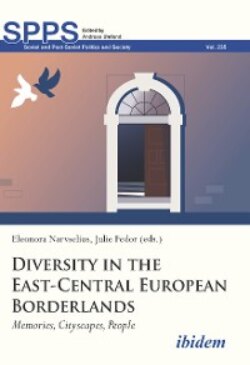Читать книгу Diversity in the East-Central European Borderlands - Группа авторов - Страница 24
На сайте Литреса книга снята с продажи.
Lwów/L’vov During and After World War II
ОглавлениеFrom 17 September 1939, the Soviet occupation legitimized itself through social and national arguments, professing the aim of uniting a “Soviet Ukrainian” nation. Soviet urban planners set out to transform the pre-war central European, multi-ethnic city into a Soviet industrial city.57 Having little understanding of the historical legacy, some “even viewed the unfamiliar environment with actual hostility” (Tscherkes 2005: 206). Nevertheless, the chief planner Oleksandr Karsianov allowed some authors of the 1938 General Plan to take part in the new planning process.58 He recognized their competence but added that “this culture has been acquired during the era of capitalism. In an architectural and artistic sense, it is barren, and lacking ideas.” He wrote that these shortcomings “can be fruitfully resolved when architects learn to implement correctly the theories of Marx, Engels, Lenin and Stalin—the key to understanding all knowledge” (ibid.: 206).59 A new General Plan concept was presented in 1940. New monumental buildings at crucial locations were to change the architectural landscape, as viewpoints from different directions and from old and new street axes. A new central square was to be created “on the ruins of the medieval ghetto” (quote from Karsianov 1940, in Tscherkes 2005: 208). These plans were never implemented.
The Nazis, too, played on the Ukrainian hope for independence. Armed conflicts between Poles and Ukrainians in 1942–43, partly instigated by the Nazis, claimed around 100,000 victims. Immediately after the German troops arrived on 30 June 1941, a pogrom, supported by many local inhabitants, until the beginning of August, claimed 8,000–9,000 Jewish victims (Friedman 1945). Labor camps were soon established on Janowska and Czwartaków Streets.60 From 15 December, all Jews were forced to live in a delimited district in north-west Lwów, including the old Jewish cemetery,61 where they had to destroy tombstones and crush them into street paving.62 In 1942, the Golden Rose synagogue from 1594 was destroyed.
From 16 March 1942 Jews were regularly either deported to the Bełżec death camp or taken to the Janowska camp, mostly to be shot at the nearby “Sands” (Piaski). Within the next ten months, 80,000–85,000 Jews were murdered. From 7 September 1942, the remaining Jews had to live in a reduced and successively shrinking ghetto north of the railway under extremely difficult conditions, causing a typhus epidemic.63 They were systematically killed until autumn 1943.64 Around 136,000 Jews from Lwów fell victim to the Holocaust, and at Janowska camp, around 200,000 persons from different places were killed (Sandkühler 1996; Wiesenthal 1989).65 Very few Lwów Jews survived, helped by other local inhabitants, with false documents and hideouts. Some were hidden by the Greek Catholic metropolitan Andrei Sheptyts’kyi in churches and monasteries (Ther 2005: 268). In spite of wartime damage to the northern and northwest sectors of the inner city, most of historical L’viv was undamaged.
After the Soviet re-conquest of Lwów/L’viv in July 1944, Russian and Ukrainian became official languages. In July 1946, 787,000 Poles were expelled from west Galicia, almost 125,000 of them from L’viv. In 1947, only 30,000 inhabitants (8.7% of the 1939 population) remained.66 New Soviet settlers gradually raised the population to 410,000 by 1959 (Ther 2005). In 1971, the city’s 566,000 inhabitants comprised 68.2% Ukrainians, 22.3% Russians, and 9.5% others. Around 25–30% of the Poles that settled in Wrocław, formerly Breslau, after the war, came from the former Polish regions ceded to the Soviet Union. In winter 1945–46, 30,000 people from Lwów settled in Wrocław, but not all of them stayed (Thum 2003: 93–99). The Poles replaced the expelled German population. In part, the former Polish urban and academic life of Lwów was able to continue in Wrocław. The university library Ossolineum opened a new branch in Wrocław, for example. To some extent the notion of Wrocław as a “second Lwów” is a myth, but there are still special relations between the two cities even today.
